Yi Guan
Causal Discovery from Time-Series Data with Short-Term Invariance-Based Convolutional Neural Networks
Aug 15, 2024Abstract:Causal discovery from time-series data aims to capture both intra-slice (contemporaneous) and inter-slice (time-lagged) causality between variables within the temporal chain, which is crucial for various scientific disciplines. Compared to causal discovery from non-time-series data, causal discovery from time-series data necessitates more serialized samples with a larger amount of observed time steps. To address the challenges, we propose a novel gradient-based causal discovery approach STIC, which focuses on \textbf{S}hort-\textbf{T}erm \textbf{I}nvariance using \textbf{C}onvolutional neural networks to uncover the causal relationships from time-series data. Specifically, STIC leverages both the short-term time and mechanism invariance of causality within each window observation, which possesses the property of independence, to enhance sample efficiency. Furthermore, we construct two causal convolution kernels, which correspond to the short-term time and mechanism invariance respectively, to estimate the window causal graph. To demonstrate the necessity of convolutional neural networks for causal discovery from time-series data, we theoretically derive the equivalence between convolution and the underlying generative principle of time-series data under the assumption that the additive noise model is identifiable. Experimental evaluations conducted on both synthetic and FMRI benchmark datasets demonstrate that our STIC outperforms baselines significantly and achieves the state-of-the-art performance, particularly when the datasets contain a limited number of observed time steps. Code is available at \url{https://github.com/HITshenrj/STIC}.
FreqTSF: Time Series Forecasting Via Simulating Frequency Kramer-Kronig Relations
Jul 31, 2024Abstract:Time series forecasting (TSF) is immensely important in extensive applications, such as electricity transformation, financial trade, medical monitoring, and smart agriculture. Although Transformer-based methods can handle time series data, their ability to predict long-term time series is limited due to the ``anti-order" nature of the self-attention mechanism. To address this problem, we focus on frequency domain to weaken the impact of order in TSF and propose the FreqBlock, where we first obtain frequency representations through the Frequency Transform Module. Subsequently, a newly designed Frequency Cross Attention is used to obtian enhanced frequency representations between the real and imaginary parts, thus establishing a link between the attention mechanism and the inherent Kramer-Kronig relations (KKRs). Our backbone network, FreqTSF, adopts a residual structure by concatenating multiple FreqBlocks to simulate KKRs in the frequency domain and avoid degradation problems. On a theoretical level, we demonstrate that the proposed two modules can significantly reduce the time and memory complexity from $\mathcal{O}(L^2)$ to $\mathcal{O}(L)$ for each FreqBlock computation. Empirical studies on four benchmark datasets show that FreqTSF achieves an overall relative MSE reduction of 15\% and an overall relative MAE reduction of 11\% compared to the state-of-the-art methods. The code will be available soon.
ProSpec RL: Plan Ahead, then Execute
Jul 31, 2024Abstract:Imagining potential outcomes of actions before execution helps agents make more informed decisions, a prospective thinking ability fundamental to human cognition. However, mainstream model-free Reinforcement Learning (RL) methods lack the ability to proactively envision future scenarios, plan, and guide strategies. These methods typically rely on trial and error to adjust policy functions, aiming to maximize cumulative rewards or long-term value, even if such high-reward decisions place the environment in extremely dangerous states. To address this, we propose the Prospective (ProSpec) RL method, which makes higher-value, lower-risk optimal decisions by imagining future n-stream trajectories. Specifically, ProSpec employs a dynamic model to predict future states (termed "imagined states") based on the current state and a series of sampled actions. Furthermore, we integrate the concept of Model Predictive Control and introduce a cycle consistency constraint that allows the agent to evaluate and select the optimal actions from these trajectories. Moreover, ProSpec employs cycle consistency to mitigate two fundamental issues in RL: augmenting state reversibility to avoid irreversible events (low risk) and augmenting actions to generate numerous virtual trajectories, thereby improving data efficiency. We validated the effectiveness of our method on the DMControl benchmarks, where our approach achieved significant performance improvements. Code will be open-sourced upon acceptance.
Causal prompting model-based offline reinforcement learning
Jun 03, 2024Abstract:Model-based offline Reinforcement Learning (RL) allows agents to fully utilise pre-collected datasets without requiring additional or unethical explorations. However, applying model-based offline RL to online systems presents challenges, primarily due to the highly suboptimal (noise-filled) and diverse nature of datasets generated by online systems. To tackle these issues, we introduce the Causal Prompting Reinforcement Learning (CPRL) framework, designed for highly suboptimal and resource-constrained online scenarios. The initial phase of CPRL involves the introduction of the Hidden-Parameter Block Causal Prompting Dynamic (Hip-BCPD) to model environmental dynamics. This approach utilises invariant causal prompts and aligns hidden parameters to generalise to new and diverse online users. In the subsequent phase, a single policy is trained to address multiple tasks through the amalgamation of reusable skills, circumventing the need for training from scratch. Experiments conducted across datasets with varying levels of noise, including simulation-based and real-world offline datasets from the Dnurse APP, demonstrate that our proposed method can make robust decisions in out-of-distribution and noisy environments, outperforming contemporary algorithms. Additionally, we separately verify the contributions of Hip-BCPDs and the skill-reuse strategy to the robustness of performance. We further analyse the visualised structure of Hip-BCPD and the interpretability of sub-skills. We released our source code and the first ever real-world medical dataset for precise medical decision-making tasks.
Blood Glucose Control Via Pre-trained Counterfactual Invertible Neural Networks
May 23, 2024Abstract:Type 1 diabetes mellitus (T1D) is characterized by insulin deficiency and blood glucose (BG) control issues. The state-of-the-art solution for continuous BG control is reinforcement learning (RL), where an agent can dynamically adjust exogenous insulin doses in time to maintain BG levels within the target range. However, due to the lack of action guidance, the agent often needs to learn from randomized trials to understand misleading correlations between exogenous insulin doses and BG levels, which can lead to instability and unsafety. To address these challenges, we propose an introspective RL based on Counterfactual Invertible Neural Networks (CINN). We use the pre-trained CINN as a frozen introspective block of the RL agent, which integrates forward prediction and counterfactual inference to guide the policy updates, promoting more stable and safer BG control. Constructed based on interpretable causal order, CINN employs bidirectional encoders with affine coupling layers to ensure invertibility while using orthogonal weight normalization to enhance the trainability, thereby ensuring the bidirectional differentiability of network parameters. We experimentally validate the accuracy and generalization ability of the pre-trained CINN in BG prediction and counterfactual inference for action. Furthermore, our experimental results highlight the effectiveness of pre-trained CINN in guiding RL policy updates for more accurate and safer BG control.
Apollo's Oracle: Retrieval-Augmented Reasoning in Multi-Agent Debates
Dec 08, 2023



Abstract:Multi-agent debate systems are designed to derive accurate and consistent conclusions through adversarial interactions among agents. However, these systems often encounter challenges due to cognitive constraints, manifesting as (1) agents' obstinate adherence to incorrect viewpoints and (2) their propensity to abandon correct viewpoints. These issues are primarily responsible for the ineffectiveness of such debates. Addressing the challenge of cognitive constraints, we introduce a novel framework, the Multi-Agent Debate with Retrieval Augmented (MADRA). MADRA incorporates retrieval of prior knowledge into the debate process, effectively breaking cognitive constraints and enhancing the agents' reasoning capabilities. Furthermore, we have developed a self-selection module within this framework, enabling agents to autonomously select pertinent evidence, thereby minimizing the impact of irrelevant or noisy data. We have comprehensively tested and analyzed MADRA across six diverse datasets. The experimental results demonstrate that our approach significantly enhances performance across various tasks, proving the effectiveness of our proposed method.
Causal Coupled Mechanisms: A Control Method with Cooperation and Competition for Complex System
Sep 15, 2022



Abstract:Complex systems are ubiquitous in the real world and tend to have complicated and poorly understood dynamics. For their control issues, the challenge is to guarantee accuracy, robustness, and generalization in such bloated and troubled environments. Fortunately, a complex system can be divided into multiple modular structures that human cognition appears to exploit. Inspired by this cognition, a novel control method, Causal Coupled Mechanisms (CCMs), is proposed that explores the cooperation in division and competition in combination. Our method employs the theory of hierarchical reinforcement learning (HRL), in which 1) the high-level policy with competitive awareness divides the whole complex system into multiple functional mechanisms, and 2) the low-level policy finishes the control task of each mechanism. Specifically for cooperation, a cascade control module helps the series operation of CCMs, and a forward coupled reasoning module is used to recover the coupling information lost in the division process. On both synthetic systems and a real-world biological regulatory system, the CCM method achieves robust and state-of-the-art control results even with unpredictable random noise. Moreover, generalization results show that reusing prepared specialized CCMs helps to perform well in environments with different confounders and dynamics.
AdvPicker: Effectively Leveraging Unlabeled Data via Adversarial Discriminator for Cross-Lingual NER
Jun 07, 2021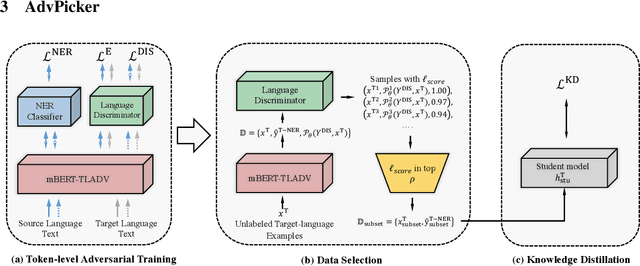
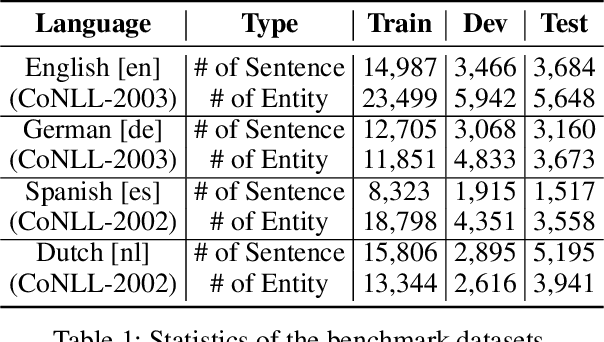
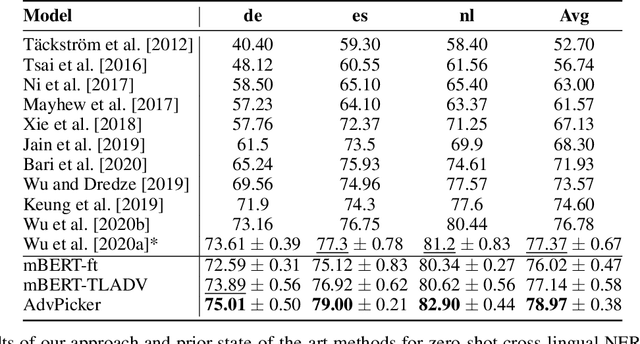

Abstract:Neural methods have been shown to achieve high performance in Named Entity Recognition (NER), but rely on costly high-quality labeled data for training, which is not always available across languages. While previous works have shown that unlabeled data in a target language can be used to improve cross-lingual model performance, we propose a novel adversarial approach (AdvPicker) to better leverage such data and further improve results. We design an adversarial learning framework in which an encoder learns entity domain knowledge from labeled source-language data and better shared features are captured via adversarial training - where a discriminator selects less language-dependent target-language data via similarity to the source language. Experimental results on standard benchmark datasets well demonstrate that the proposed method benefits strongly from this data selection process and outperforms existing state-of-the-art methods; without requiring any additional external resources (e.g., gazetteers or via machine translation). The code is available at https://aka.ms/AdvPicker
Do recommender systems function in the health domain: a system review
Jul 26, 2020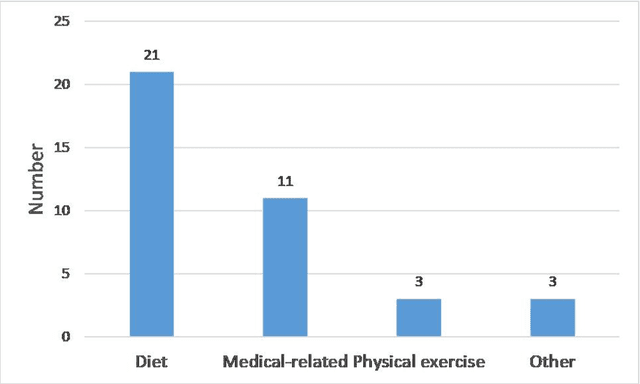
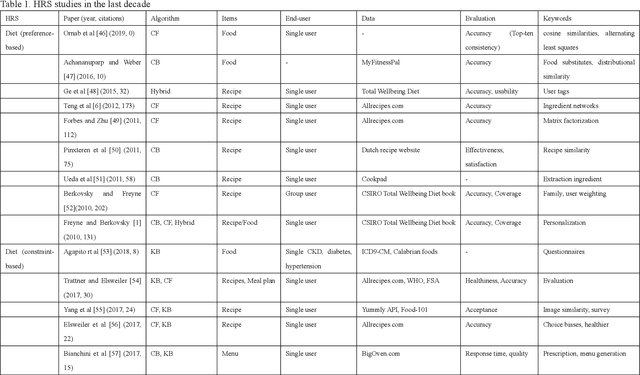
Abstract:Recommender systems have fulfilled an important role in everyday life. Recommendations such as news by Google, videos by Netflix, goods by e-commerce providers, etc. have heavily changed everyones lifestyle. Health domains contain similar decision-making problems such as what to eat, how to exercise, and what is the proper medicine for a patient. Recently, studies focused on recommender systems to solve health problems have attracted attention. In this paper, we review aspects of health recommender systems including interests, methods, evaluation, future challenges and trend issues. We find that 1) health recommender systems have their own health concern limitations that cause them to focus on less-risky recommendations such as diet recommendation; 2) traditional recommender methods such as content-based and collaborative filtering methods can hardly handle health constraints, but knowledge-based methods function more than ever; 3) evaluating a health recommendation is more complicated than evaluating a commercial one because multiple dimensions in addition to accuracy should be considered. Recommender systems can function well in the health domain after the solution of several key problems. Our work is a systematic review of health recommender system studies, we show current conditions and future directions. It is believed that this review will help domain researchers and promote health recommender systems to the next step.
Medical Knowledge Embedding Based on Recursive Neural Network for Multi-Disease Diagnosis
Sep 22, 2018



Abstract:The representation of knowledge based on first-order logic captures the richness of natural language and supports multiple probabilistic inference models. Although symbolic representation enables quantitative reasoning with statistical probability, it is difficult to utilize with machine learning models as they perform numerical operations. In contrast, knowledge embedding (i.e., high-dimensional and continuous vectors) is a feasible approach to complex reasoning that can not only retain the semantic information of knowledge but also establish the quantifiable relationship among them. In this paper, we propose recursive neural knowledge network (RNKN), which combines medical knowledge based on first-order logic with recursive neural network for multi-disease diagnosis. After RNKN is efficiently trained from manually annotated Chinese Electronic Medical Records (CEMRs), diagnosis-oriented knowledge embeddings and weight matrixes are learned. Experimental results verify that the diagnostic accuracy of RNKN is superior to that of some classical machine learning models and Markov logic network (MLN). The results also demonstrate that the more explicit the evidence extracted from CEMRs is, the better is the performance achieved. RNKN gradually exhibits the interpretation of knowledge embeddings as the number of training epochs increases.
 Add to Chrome
Add to Chrome Add to Firefox
Add to Firefox Add to Edge
Add to Edge